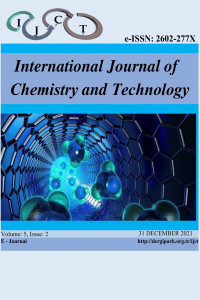Abstract
Chlorpyrifos is an solid organophosphorus pesticide widely used in agriculture. It is relatively stable to hydrolysis in neutral pH and acidic aqueous solutions. Stability decreases with increasing pH. Chlorpyrifos practically insoluble in water, but highly soluble in most organic solvents such as acetone xylene and methyl bromide. It is an effective skin, stomach and respiratory insecticide and is effective against aphids, spider mites, soil bugs and house pests. It is also highly toxic bees and fish. Most pesticides are complex organic molecules and are persistent in the environment, either biota or accumulate in the environment. In pesticide-used areas, the pesticide itself or its residues are transported by rain and irrigation water and mixes into groundwater. The effects caused by the pesticide are closely related to the level of accumulation. During the studies, contamination of chlorpyrifos has been found about 24 km from the site of its application. There are many physico-chemical and biological approaches to remove organophosphorus pesticides from the ecosystem, among them most promising is biodegradation. In this study, the biodegradation potential of chlorpyrifos with P. Putida was investigated in the batch stirred reactor. In the optimum conditions, the maximum pesticide removal rate was determined as 1.51 mg/g. d. m.o.h.
Keywords
References
- 1. Haktanır, K. A. Ü. Ziraat Fakültesi, T. no:107, 1985, Ankara.
- 2. Barlas, N. Tübitak 1996. Project: YDABÇAG 217/A.
- 3. Güler, Ç.; Uz, H.; Sur, H. TSE Standard Ekonomik ve Teknik Dergi,1998, 440(37), 54-59.
- 4. Ünlü, K.; Özenirler, G.; Sözüdoğru, S. Turkish J Eng Env Sci., 1997, 21, 189-202.
- 5. William, M.D.; Coates, J.A.; Garcia, K.L.; Signorella, L.L.; Delfino, J.J. J. Chromatogr. A, 1993, 643, 341-350.
- 6. Yıldırım, E. Tarımsal Zararlılarla Mücadele Yöntemleri ve Kullanılan İlaçlar. Atatürk Üniv. Ziraat Fak. Yayınları, No:219, Erzurum, 350 s. 2008.
- 7. Baltensweiler, W. Z. Ang. Ent., 1985, 99:77-85.
- 8. Güler, Ç.; Uz, H.; Sur, H. TSE Standard Ekonomik ve Teknik Dergi,1998, 440(37), 54-59.
- 9. Gürman, A. Kimya Mühendisliği Dergisi, 1993, 138. Sayı.
- 10. Öztürk, S. Tarım İlaçları, Hasat Yayıncılık, İstanbul. 1990.
- 11. Ecevit, O.; Bayraklı, F. Pestisit kalıntı sorunu ve Önemi, Çölleşen Dünya ve Türkiye Örneği, T.C. A.Ü. Çevre Sorunları Araştırma Merkezi, Erzurum. 13-17 Mayıs, 1985.
- 12. Güvener, A. Pestisit Kalıntı Sorunları, I. Ulusal Zirai Mücadele İlaçları Sempozyumu, DİE, Ankara.27-29 Kasım, 1980.
- 13. Türkiye Çevre Vakfı, 1995, Türkiye’nin Çevre Sorunları’95, Altıncı Baskı, Önder Matbaa, Ankara, 1995.
- 14. Ayas, Z.; Barlas, N.; Kolankaya, D. Aquat. Toxicol. 1997, 39(2)171-181.
- 15. İnce, N.; Bekbölet, M. Türkiye’de Pestisit Tüketimine İlişkin Kirlenme Öncelikleri, Türkiye’de Çevre Kirlenmesi Öncelikleri Sempozyumu, 21-22 Mayıs, İstanbul, 1991.
- 16. Falmann, H.; Krutzler, T.; Bauer, R.; Malato, S.; Blanco, J. Catal. Today, 1999, 54, 309-319.
- 17. Aksu, Z. Process Biochem 2005., 40, 997-1026.
- 18. Bellinaso, M. L.; Greeer, C. W.; Peralba, M. C. C.; Henriques, J.A.P; Gaylarde, C.C. FEMS Microbiol. Ecol. 2003, 43, 191-194.
- 19. Sanchez, M.E.; Estrada, I.B.; Martinez O.; Martin-Villacorta, J.; Aller, A.; Moran, A. Chemosphere, 2004, 57, 673-679.
- 20. Tutarlı, A. Elazığ’da Tarımsal Mücadele Amacıyla Kullanılan Pestisitlerin Topraktaki Kalıntılarının Araştırılması, Master's Dissertation, F.Ü. Fen Bilimleri Enstitüsü, Elâzığ, 1991.
- 21. Buitron, G.; Koeffed, A.; Capdeville, B. Envıron Technol, 993, 14, 227-236.
- 22. Barlas, N. Tübitak 1996. Project: YDABÇAG 217/A.
Abstract
References
- 1. Haktanır, K. A. Ü. Ziraat Fakültesi, T. no:107, 1985, Ankara.
- 2. Barlas, N. Tübitak 1996. Project: YDABÇAG 217/A.
- 3. Güler, Ç.; Uz, H.; Sur, H. TSE Standard Ekonomik ve Teknik Dergi,1998, 440(37), 54-59.
- 4. Ünlü, K.; Özenirler, G.; Sözüdoğru, S. Turkish J Eng Env Sci., 1997, 21, 189-202.
- 5. William, M.D.; Coates, J.A.; Garcia, K.L.; Signorella, L.L.; Delfino, J.J. J. Chromatogr. A, 1993, 643, 341-350.
- 6. Yıldırım, E. Tarımsal Zararlılarla Mücadele Yöntemleri ve Kullanılan İlaçlar. Atatürk Üniv. Ziraat Fak. Yayınları, No:219, Erzurum, 350 s. 2008.
- 7. Baltensweiler, W. Z. Ang. Ent., 1985, 99:77-85.
- 8. Güler, Ç.; Uz, H.; Sur, H. TSE Standard Ekonomik ve Teknik Dergi,1998, 440(37), 54-59.
- 9. Gürman, A. Kimya Mühendisliği Dergisi, 1993, 138. Sayı.
- 10. Öztürk, S. Tarım İlaçları, Hasat Yayıncılık, İstanbul. 1990.
- 11. Ecevit, O.; Bayraklı, F. Pestisit kalıntı sorunu ve Önemi, Çölleşen Dünya ve Türkiye Örneği, T.C. A.Ü. Çevre Sorunları Araştırma Merkezi, Erzurum. 13-17 Mayıs, 1985.
- 12. Güvener, A. Pestisit Kalıntı Sorunları, I. Ulusal Zirai Mücadele İlaçları Sempozyumu, DİE, Ankara.27-29 Kasım, 1980.
- 13. Türkiye Çevre Vakfı, 1995, Türkiye’nin Çevre Sorunları’95, Altıncı Baskı, Önder Matbaa, Ankara, 1995.
- 14. Ayas, Z.; Barlas, N.; Kolankaya, D. Aquat. Toxicol. 1997, 39(2)171-181.
- 15. İnce, N.; Bekbölet, M. Türkiye’de Pestisit Tüketimine İlişkin Kirlenme Öncelikleri, Türkiye’de Çevre Kirlenmesi Öncelikleri Sempozyumu, 21-22 Mayıs, İstanbul, 1991.
- 16. Falmann, H.; Krutzler, T.; Bauer, R.; Malato, S.; Blanco, J. Catal. Today, 1999, 54, 309-319.
- 17. Aksu, Z. Process Biochem 2005., 40, 997-1026.
- 18. Bellinaso, M. L.; Greeer, C. W.; Peralba, M. C. C.; Henriques, J.A.P; Gaylarde, C.C. FEMS Microbiol. Ecol. 2003, 43, 191-194.
- 19. Sanchez, M.E.; Estrada, I.B.; Martinez O.; Martin-Villacorta, J.; Aller, A.; Moran, A. Chemosphere, 2004, 57, 673-679.
- 20. Tutarlı, A. Elazığ’da Tarımsal Mücadele Amacıyla Kullanılan Pestisitlerin Topraktaki Kalıntılarının Araştırılması, Master's Dissertation, F.Ü. Fen Bilimleri Enstitüsü, Elâzığ, 1991.
- 21. Buitron, G.; Koeffed, A.; Capdeville, B. Envıron Technol, 993, 14, 227-236.
- 22. Barlas, N. Tübitak 1996. Project: YDABÇAG 217/A.
Details
| Primary Language | English |
|---|---|
| Subjects | Environmental Engineering |
| Journal Section | Research Articles |
| Authors | |
| Publication Date | December 31, 2021 |
| Published in Issue | Year 2021 Volume: 5 Issue: 2 |
Cite
This work is licensed under a Creative Commons Attribution-NonCommercial 4.0 International License.



